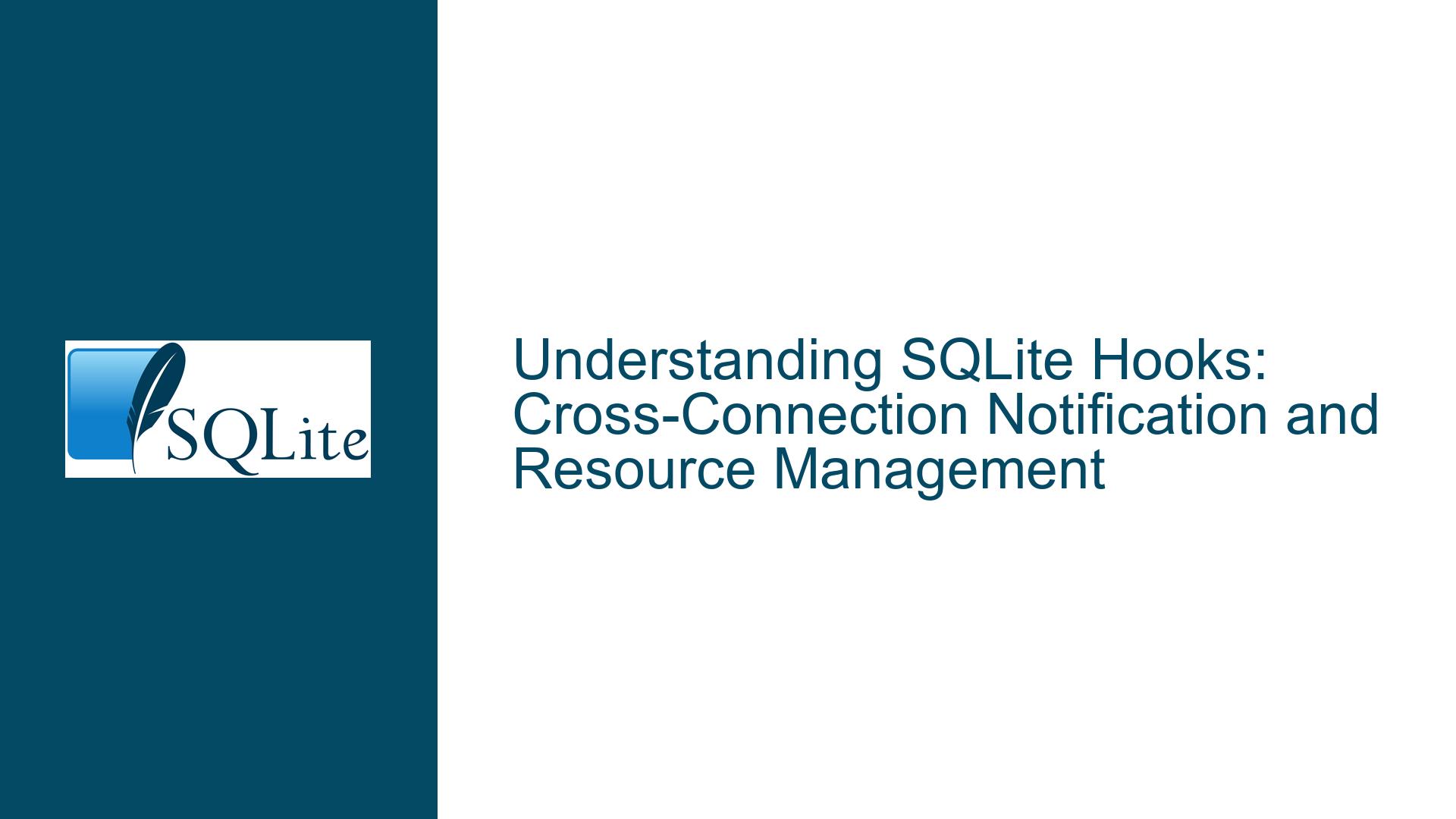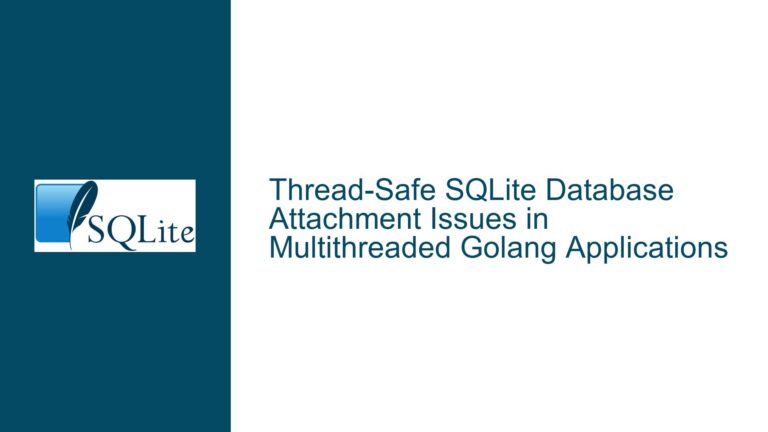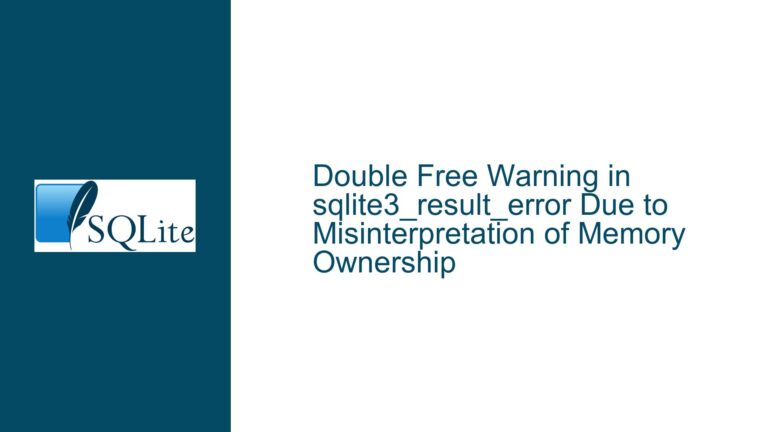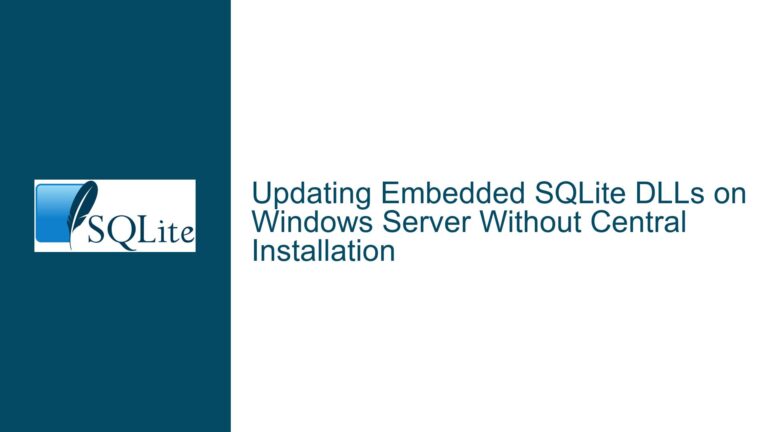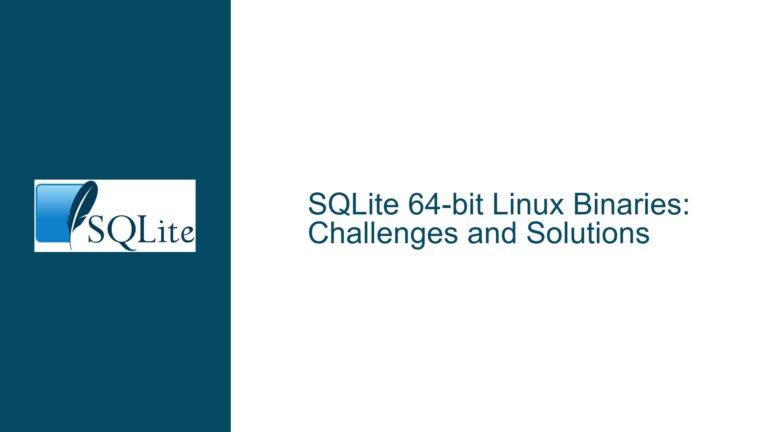SQLite Hooks: Cross-Connection Notification and Resource Management
SQLite Hook Behavior Across Connections and Event Granularity Constraints
Core Challenge: Monitoring Cross-Connection Database Changes and Optimizing Hook Performance
The primary challenge revolves around SQLite’s hook system and its limitations in two key areas:
- Cross-connection change notification: Hooks registered on one database connection are not triggered by modifications made through other connections.
- Event granularity: Hooks cannot filter events by specific tables or operations (e.g., updates on "TableA" only), requiring handlers to process all modifications across all tables.
These limitations raise concerns about resource efficiency and the feasibility of using hooks for targeted monitoring. SQLite’s design prioritizes simplicity and portability, which inherently restricts the scope of hooks to the connection where they are registered. This behavior is rooted in SQLite’s architecture, where each connection operates as an independent entity with isolated state management.
A secondary concern is the potential performance overhead of hooks. Since a hook must process every modification event (inserts, updates, deletes) across all tables, applications requiring fine-grained control may incur unnecessary processing costs. This becomes critical in high-throughput scenarios or when monitoring large schemas with frequent modifications.
Root Causes: Connection Isolation and Hook Design Limitations
1. Connection-Level Hook Registration and Scope
SQLite hooks are scoped to the database connection where they are registered. Each connection maintains its own set of hooks, authorizers, and transaction state. When Connection A modifies the database, Connection B’s hooks remain unaware of these changes. This isolation ensures thread safety and avoids global state synchronization, which aligns with SQLite’s embedded database philosophy.
Key architectural factors:
- No inter-process communication (IPC): SQLite does not implement a client-server model. Connections operate independently unless explicitly coordinated through mechanisms like shared cache mode or
ATTACH DATABASE. - Transaction-local visibility: Uncommitted changes from one connection are invisible to others until the transaction is finalized. Hooks fire only for modifications made within their own connection’s transaction context.
2. Absence of Table/Operation-Specific Filtering in Hooks
SQLite’s sqlite3_update_hook provides a callback for row-level changes but does not expose table names or operation types to the handler. For example:
void sqlite3_update_hook(
sqlite3 *db,
void(*callback)(void *arg, int op, char *dbname, char *tblname, sqlite3_int64 rowid),
void *arg
);
While tblname is available, the hook cannot be configured to listen only for updates on "TableX" or ignore inserts on "TableY". This forces developers to implement filtering logic within the callback, which adds overhead if most events are irrelevant.
3. Resource Consumption and Execution Context
Hooks execute synchronously within the thread that performs the database operation. A poorly optimized hook handler can block subsequent modifications, leading to latency spikes. While SQLite itself imposes minimal overhead, user-defined hook logic (e.g., logging, validation) can become a bottleneck.
Solutions: Workarounds, Optimization Strategies, and Alternatives
1. Cross-Connection Monitoring via Shared State or External Systems
To track changes across connections:
- Shared cache mode: Enable
SQLITE_OPEN_SHAREDCACHEto allow connections to share a common page cache. While this does not propagate hooks, it reduces I/O overhead and enables limited coordination viasqlite3_unlock_notify. - Application-layer notification: Implement a pub/sub system (e.g., using inter-process signals or a dedicated table with triggers) to broadcast change events between connections.
- File-system monitoring: Watch for database file modifications using OS APIs (e.g.,
inotifyon Linux). This detects commits but not granular changes.
Example using triggers for cross-connection signaling:
-- In Connection A
CREATE TEMP TABLE IF NOT EXISTS change_log (
op_type TEXT,
table_name TEXT,
rowid INTEGER,
timestamp DATETIME DEFAULT CURRENT_TIMESTAMP
);
CREATE TRIGGER temp.table1_after_update AFTER UPDATE ON Table1
BEGIN
INSERT INTO change_log (op_type, table_name, rowid) VALUES ('UPDATE', 'Table1', NEW.rowid);
END;
-- In Connection B (polling)
SELECT * FROM temp.change_log WHERE timestamp > last_poll_time;
2. Granular Event Filtering with Authorizers and Triggers
Alternative 1: Use sqlite3_set_authorizer
The authorizer callback provides detailed context about database operations, including table names and operation types. Unlike hooks, authorizers can deny operations but are invoked before execution, making them suitable for validation rather than post-hoc logging.
Example authorizer for table-specific monitoring:
int authorizer_callback(
void *userdata,
int action_code,
const char *param1,
const char *param2,
const char *dbname,
const char *trigger_name
) {
if (action_code == SQLITE_UPDATE && strcmp(param1, "Table1") == 0) {
log_update_operation(param2 /* column name */);
}
return SQLITE_OK;
}
sqlite3_set_authorizer(db, authorizer_callback, NULL);
Alternative 2: Table-specific triggers
Triggers offer native support for per-table event handling. While they modify the schema, they provide exact control over which operations to monitor:
CREATE TABLE audit_log (
op_type TEXT,
table_name TEXT,
old_data TEXT,
new_data TEXT,
timestamp DATETIME DEFAULT CURRENT_TIMESTAMP
);
CREATE TRIGGER table1_after_update AFTER UPDATE ON Table1
BEGIN
INSERT INTO audit_log (op_type, table_name, old_data, new_data)
VALUES ('UPDATE', 'Table1', OLD.column1, NEW.column1);
END;
3. Optimizing Hook Performance
- Minimal filtering in hooks: Quickly discard irrelevant events using early returns.
void update_hook_handler(void *arg, int op, const char *dbname, const char *tblname, sqlite3_int64 rowid) {
if (strcmp(tblname, "TargetTable") != 0) return;
// Process only TargetTable events
}
- Dynamic hook registration: Remove hooks during bulk operations or maintenance tasks.
// Disable hook before bulk insert
sqlite3_update_hook(db, NULL, NULL);
execute_bulk_insert();
sqlite3_update_hook(db, update_hook_handler, NULL);
- Asynchronous processing: Buffer hook events in a queue and process them in a separate thread to avoid blocking the database connection.
4. Concurrency and Mutex Considerations
SQLite’s sqlite3_mutex APIs allow customizing lock management, but hooks operate under the same mutex rules as other connection activities. To prevent deadlocks:
- Avoid long-running operations in hooks.
- Use
SQLITE_CONFIG_MULTITHREADorSQLITE_CONFIG_SERIALIZEDthreading modes appropriately.
Final Recommendations:
- Use triggers for table-specific change tracking within the same database.
- Combine authorizers and hooks for pre-execution validation and post-execution logging.
- Implement application-layer coordination for cross-connection monitoring.
- Profile hook handlers under load to identify performance bottlenecks.
By leveraging SQLite’s extensibility and supplementing it with application logic, developers can achieve robust change monitoring while respecting the database’s design constraints.
